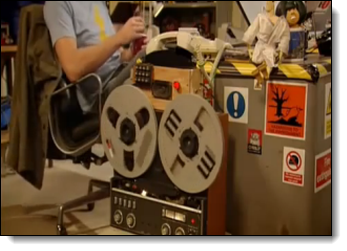Rod is the founder of PRD Software, and loves to code, write, play guitar, hit tennis balls hard, and everything to do with helpdesk, …

People, Process and Technology
If you had to choose only 2 from the 3 words above as ’tools’ that could be used to implement service management and helpdesk delivery, which would you pick?
A tough one eh?
- Remove people, and we’re staring down the barrel of the technological singularity.
- Remove process and you’ve got automated chaos.
- Remove technology, and we’re back to smoke signals.
Process and technology?
Consider technology and process. They are a perfect match. In fact, one can’t exist with the other. If it were not for the rigid processes of pure mathematics, binary codes and pulses of electricity vacillating at a Mooreish pulse rate, the technology of computers as we know them would not exist. Computers need process to work.
Technology is process.

But it doesn’t stop at the hardware. Hardware is just the enabler for software, and this is where the real processes begin.
Software has become the metaphor through which business is mapped. It is the canvas on which we design our processes, the storage vessel that contains our information. Software is nothing more than an electronic mirror of the business world that we have come to rely on to describe, manage, and govern our digital lives by…and that’s precisely why we love it. It gives us a forum to create, to express, and to automate. Transferring thought and process to an external medium can be therapeutic, liberating, enabling. It’s revealing.
Software has changed the world.
Processes and technology have changed the world.
The software market for the helpdesk and ITSM industry keeps attracting new offerings by the month…by SAAS, by PAAS, by crikey!
The Vital ITIL Recital
ITIL is a framework. Books of guidelines designed to assist with the processes that are typically found in service management. Even though ITIL could be implemented via different coloured Post-It notes, smoke signals, or for that matter, any structured, measured process, most modern businesses choose to use helpdesk-oriented software to realize the benefits that ITIL speaks of. And why not? Software and processes are made for each other. Another perfect match, except for the vital missing element.
People.
ITIL is enthusiastically spruiked from vendors and educators who make their regular pilgrimage to the sacred convention halls of ITSMF, SDI and HDI events around the globe. Their motto is clear, their evangelizing focussed -
“People, process and Technology”.
It’s the ITIL way.
It’s a great pitch, and the proselytizing works. People love processes. We thrive on them. We build them, refine them, document them, describe them, and implement them. It’s how we get the job done. (At least if you’re CMMI Level 1 and higher anyway)
People love software. Especially IT people.
So now, not only do we have the blessed ITIL books (complete with the old, and new accounts, along with various apocryphal additions) that provide guidance and process coming down from the governing body, but we also have ever increasing denominations of software models with their disciples that allow for the transfer of real-life actions, process and service delivery objectives into the digital world…
…to be used in the real world.
And this is where the technology and the process and the people and the software really shrine….shine.
Automation, automaton, or just great service?
Any service management software worth its obfuscated-code should be able to automate many processes within the ITIL and KCS (Knowledge Centred Support) stack. Things like the automation of knowledge production, linking of problems to incidents, breach notification, email conversion, SLA response alerting, skill-based routing, workload balancing, self-help knowledge suggestion, resolution scripts, Active Directory synchronization, major incident notification, network monitoring… and so on and so forth…
All good features that make for short work on a vendor capability questionnaire, however it does raise the question – “Where is automation taking us?” Are these good things? Where will this end?
Some questions come to mind.
- What are the chances that humans will automate themselves out of the service management loop?
- What are the odds that people will not only implement “Nanorep”-like technology to serve the customer, but come to fully rely on it? And is this a * good thing? “Press #4?” anyone?
- What is the likelihood that the Loebner prize is awarded to HelpMaster one day? :-)
- What is the probability that Pink Verify or its successor has a checkbox for a “Loebner Prize” winner?
- To what extent will Android become a player in the mobile service management space?
That last one….Android. Not so much an operating system as it is the modus operandi for helpdesks and call centres around the world. Haven’t some helpdesk people already become androids, which is to say, robots?
“Have you tried turning it on and off again?”
The first time we’re introduced to Roy from the “IT Crowd”, he’s in mid-helpdesk telephone conversation. Being worn down by the monotony of helpdesk life, like a programmed drone he defaults to his habitual response of “Have you tried turning it off and on again?” (Watch it)

Exasperated. Desperate. Frustrated. Helpdesk.
In true IT geek, “www.hackaday.com ” style, a few episodes later, Roy has rigged up a mechanical device to automate his automation.

Automate his automation!
Roy’s side-kick Moss, although a different automaton beast, has an atypical (for “normal” folk), albeit no-less mechanical approach to service delivery. By Series 4, in “Bad Boys”, Roy has the following conversation with Jen, the IT Manager whilst on the phone to a client.
ROY (whilst on phone to customer, says to Jen): I’m giving phone support.
ROY (To customer on phone): OK, so how did that go?….(listens)… Yeah, but that’s an important part of the process. Yes, if you don’t complete that part, there’s no way you’re going to be able to do the next bit… OK, so now…TURN IT BACK ON AGAIN!
ROY (To Jen under his breath): People!
JEN: That is rude! What is that?
ROY: Oh, Jen, I have to say “Have you tried turning it on and off again” about a thousand times a day. It’s like a catchphrase. If it wasn’t for you and Moss, it would be the only thing I would say.
JEN: It doesn’t matter; don’t take your bad career decisions out on the users.
ROY: I’m not saying it again today! You know they can just figure it out for themselves.
JEN: You’ll never go a whole day without saying it….
ROY: You don’t think I can?
Poor Roy.
Poor Roy!? Poor users! – They’re the ones getting the blunt end of automation, albeit in human form.
Yet automation beckons. As Roy has already attempted, anything that a human has to do “a thousand times a day” is going to be replaced by a robot sooner or later. It’s inevitable.
Is the IT Crowd just brilliant comedy, poking fun at the geeks at the coal-face of the IT helpdesk? Do people really behave like this? Ask anyone who has ever spent any time in the trenches of a helpdesk, and they’ll tell you how close to the mark this is. Scarily close. Satire works because it’s based in reality.
Robots we talk to
Robots like Roy.
Not convinced? Think about this.
When you attempt to call your phone provider regarding a support call, no doubt you’ll talk with a real robot first – “Press 1 for sales, 2 for support, 3 for billing…”
The forth option sounds hopeful for those craving empathy. ”….4 for a human…”.
#4…..
…glockenspiel music….bbzzt…..click… “Hello and welcome to Wizbang Widgets”
(before you have a chance to speak)
“Let me start with your name” (was this a question?)
“What is your number...”
“What is your issue...”
...(looks up known error database). Knowledge Centred Support (KCS) + ITIL training kicking in....
“Have you tried rebooting your machine?!”
???!#@#?
Don’t be fooled by option 4. It’s not human. #4 is simply a robot in training!
Or is it? And this is the point!

Isn’t #4 just a human that’s been caught between “people, process, and technology?”
It begs the question, “But which one are they?” Has not the person become the process, likely following the script provided by the technology? Or are they the technology, providing a slightly-better voice synthesis and OCR than Microsoft Mike for reading from a script?
Is their humanity intact? They have your name, but do they have rapport?
Does ITIL and service delivery really need “people”? What’s wrong with just a process, some technology and a drone?
When was the last time you spoke with a person on option #4 that sounded and spoke like a real person? When was the last time that a telemarketer spoke to you like a real person, in a conversational manner?
YOU: “Hey, sales guy…. please! Put the script away and just ask me how I am and speak to me as a real person, not as a prospect.”
Perhaps option #1 was the better choice?
Open the pod bay doors, HAL
As technology gets faster and more powerful, as software becomes more sophisticated and intelligent, and processes become further refined, we’re in danger of automating ourselves out of the very thing that makes us, us.
We’re in danger of losing the humanity. ITSM is entering unchartered, yet exciting waters, and it might get a little choppy. Like HAL 9000, the brilliant, (yet ultimately flawed) computer that caused Dave and a few others some serious grief (death) from rigidly adhering to process, the ITSM world stands at the crossroads of innovation, automation and expectation. Unlike HAL 9000, however, we still have people in the loop…for now.
So the next time you hear or read the phrase “People, Process, Technology”, give thought to the possibility that the only real people are the people at the end of the phone line – the one’s asking for help. The ones that ITIL labels as clients, customers, users, or something like that. Anything but people.
Perhaps they are the only people left in the whole ITSM equation. Like Roy, Moss and countless others, could it be that the IT geeks have long lost their humanity, and are misplaced somewhere between process and technology?
Lost in a world where “Intelligent Technology Singularity Manifestation” will replace the #ITSM hashtag of the early 21st century.

This post was originally published on the old HelpMaster blog site in October 2011